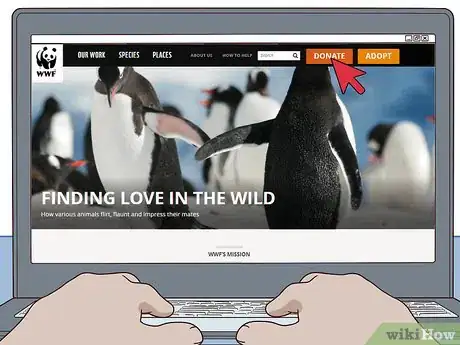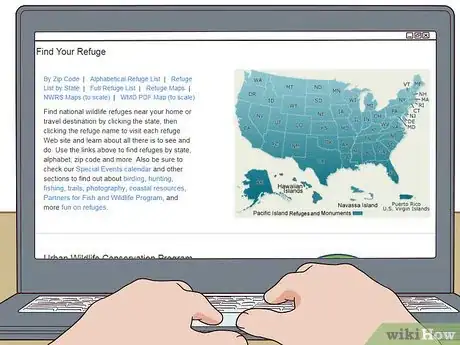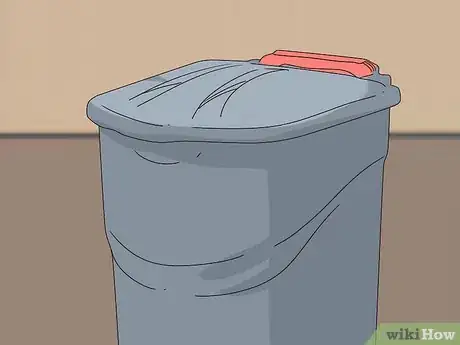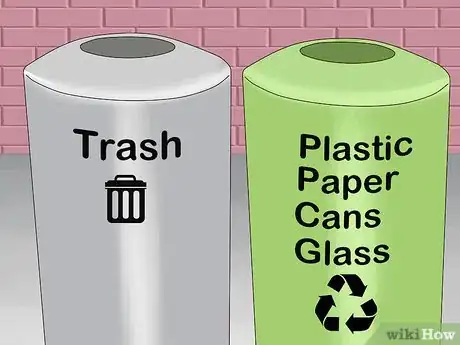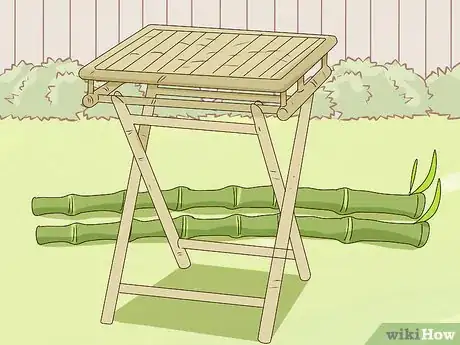This article was co-authored by wikiHow staff writer, Hunter Rising. Hunter Rising is a wikiHow Staff Writer based in Los Angeles. He has more than three years of experience writing for and working with wikiHow. Hunter holds a BFA in Entertainment Design from the University of Wisconsin - Stout and a Minor in English Writing.
This article has been viewed 52,489 times.
Learn more...
Many animals threatened with extinction are losing their habitats or being hunted by humans. If you want to prevent extinction, there are ways to support organizations and change your lifestyle to help keep animals safe. You can choose to either donate time or money to support programs that fight extinction or you can help fight local extinction from home. With enough people supporting the cause, you can help save the animals!
Steps
Donating Time and Money
-
1Give monetary donations to wildlife funds to help animals worldwide. Many non-profit organizations help with the conservation of endangered species and accept donations through their website. Research and pick a non-profit organization, such as the World Wildlife Fund (WWF) or Association of Zoos & Aquariums (AZA), before choosing the amount you wish to donate. Provide your credit card information so they can use the funds to help save animals.[1]
- You may choose to make a one-time donation or have a monthly recurring donation to help support the foundation throughout the year.
- The WWF also offers gifts or “adoption kits” when you choose an animal to protect, though it will use some of the funds you donated to pay for them. If you want all of your funds to go towards conservation, you can choose not to receive a gift.
Tip: Make sure the site you’re using provides detailed information about how your donation is used. If a website ever asks you to donate immediately, research them first since they could be charity scams.
-
2Visit zoos and aquariums that support conservation efforts. Zoos and aquariums aren’t just for seeing animals up close, but they can help save endangered species. Many of them partner with the AZA to help breed species that are endangered and help reintroduce species to help stimulate the population. Take a trip to the nearest accredited location and consider donating to them to further their efforts.[2]
- You can find a list of accredited zoos and aquariums to visit here: https://www.aza.org/find-a-zoo-or-aquarium.
Advertisement -
3Volunteer at local wildlife refuges to help protect local species. Wildlife refuges and national parks are protected lands where animals can roam free in their habitats. Contact the closest nature preserve and ask if they need any help volunteering. They may need help with educational visits or maintaining the area.[3]
- You can find a list of wildlife refuges here: https://www.fws.gov/refuges/.
- Some duties you may have include cleaning trails, building maintenance, or greeting people at a visitor’s center.
-
4Look for global volunteering opportunities to be hands-on. If you want to travel the world and get up close experience with the animals you want to save, try finding a volunteer organization that works with conservation. Look up programs associated with the species you want to work with and book the time you want to volunteer![4]
- For example, if you want to help Indian elephants, the Surin Project helps protect the animals from human abuse and neglect.
- Many volunteer programs are for 1 week, but they may have the option to extend your stay.
- Depending on where in the world you want to go, the cost to get involved with the programs may vary.
-
5Start a fundraiser to get others to donate to the cause with you. Choose an organization that you’d like to support, and then plan a fun event for your fundraiser, such as a bake sale, silent auction, or car wash. Ask any friends if they’d like to help volunteer or spread the word about your event. Choose an achievable goal you’d like to reach to give to the organization. Make sure to be clear about the cause you’re supporting so others know where the money is going.
- You may also try crowdfunding on websites like Indiegogo or Kickstarter.
Tip: Some social media sites, such as Facebook, have the option to set up a fundraiser for a non-profit organization so it’s easy to share with your friends.
Fighting Extinction at Home
-
1Make your home wildlife friendly. Make sure to keep any trash cans sealed so animals can’t get in and eat any harmful objects. Lock any outside pet doors if you have them so wild animals aren’t attracted to your yard or home. If you have birdbaths, make sure to clean and disinfect them weekly to prevent any diseases from spreading between species.[5]
- You can learn about animals that are endangered locally here: http://endangered.fws.gov.
- Put decals on large windows so birds don’t fly into them.
-
2Keep native plant life in your yard to support the ecosystem. Plants that naturally grow in your yard are perfect habitats for various small animals and insects. Keep and take care of the plants instead of taking them out of your yard to provide shelter and food sources for wild animals.[6]
- Avoid using non-native plants while you landscape your yard since local wildlife may be affected.
Tip: Don’t use pesticides or herbicides if you don’t need to since they can take a long time to degrade in the soil. If you absolutely need to apply one, look for a product that is eco-friendly.
-
3Recycle as much as possible. Trash and landfills cause pollution and may take a long time to degrade. Instead of throwing everything out right away, look for ways that you can reuse products. Keep a recycle bin in your home to get rid of aluminum, paper, and cardboard so it isn’t sent to a landfill.[7]
- Make compost with your food scraps and natural products to help enrich the soil in your yard.
-
4Say no to disposable plastic when you can. Plastic takes years to degrade in nature, so do your best to reduce your plastic usage. Opt for paper or reusable tote bags when you go shopping. Instead of using a straw at a restaurant, sip your drink or bring a reusable straw. By limiting your plastic use, you can help prevent ocean pollution and the species it affects.[8]
- Reuse any plastic products that you can. For example, rinse out food containers so you can use them for storage.
-
5Buy sustainable products that don’t damage animal habitats. Sustainable products help reduce habitat loss, one of the main contributing factors to species extinction. Look for eco-friendly products and avoid getting anything made from rainforest wood or endangered animals, such as ivory.[9]
- Bamboo is a stylish wood that is also sustainable.
Community Q&A
-
QuestionWhat if I'm at home with no truck?
 Community AnswerJoin an online environmental organization. You can raise awareness by sharing educational material.
Community AnswerJoin an online environmental organization. You can raise awareness by sharing educational material. -
QuestionBut what if you are a kid and can't donate and do stuff like that? What is the best way to help as a kid?
 Iris8989Community AnswerThere are a lot of other ways you can contribute. Ask your parents to donate and say that it helps endangered animals and species. Make an endangered animals club at your school and ask the principal for your school to use eco-friendly products (and not plastic packaging). Write an endangered animals essay for everyone to read. Lastly, you can conserve in your own home by turning off the lights when not in the room, using recyclable packaging, and riding a bike to school instead of riding in a car, which pollutes the air when gases come out of it.
Iris8989Community AnswerThere are a lot of other ways you can contribute. Ask your parents to donate and say that it helps endangered animals and species. Make an endangered animals club at your school and ask the principal for your school to use eco-friendly products (and not plastic packaging). Write an endangered animals essay for everyone to read. Lastly, you can conserve in your own home by turning off the lights when not in the room, using recyclable packaging, and riding a bike to school instead of riding in a car, which pollutes the air when gases come out of it.
Warnings
- Some animals go extinct naturally. Choose to support animals that are directly endangered by humans for the best chances of saving the species.⧼thumbs_response⧽
References
- ↑ https://support.worldwildlife.org/site/SPageServer?pagename=main_monthly&s_src=AWE1907OQ18299A01179RX&_ga=2.238965440.1310763289.1547858545-663321787.1547858545&_gac=1.221155690.1547858545.Cj0KCQiAj4biBRC-ARIsAA4WaFjvT_aEACPzzOAu8JJByVYkggOBkHlSu65g2gjT-nRb2NIEyQyKDjoaAlzLEALw_wcB
- ↑ https://www.scientificamerican.com/article/how-do-zoos-help-endangered-animals/
- ↑ http://www.endangered.org/10-easy-things-you-can-do-to-save-endangered-species/
- ↑ https://www.transitionsabroad.com/listings/work/volunteer/articles/ten-volunteer-projects-endangered-animals-abroad.shtml
- ↑ http://www.endangered.org/10-easy-things-you-can-do-to-save-endangered-species/
- ↑ http://www.endangered.org/10-easy-things-you-can-do-to-save-endangered-species/
- ↑ http://www.endangered.org/10-easy-things-you-can-do-to-save-endangered-species/
- ↑ http://www.endangered.org/10-easy-things-you-can-do-to-save-endangered-species/
- ↑ http://www.endangered.org/10-easy-things-you-can-do-to-save-endangered-species/
About This Article
To help save animals from extinction, recycle as much as you can and limit how much disposable plastic you buy since trash and plastic negatively impact animals all around the world. Also, try to buy products that are eco-friendly and sustainable. If you have a yard or garden, grow native plant life to support your local ecosystem, and avoid using pesticides and herbicides. You can also donate to wildlife organizations, like the World Wildlife Fund. To learn how you can volunteer to help save animals from extinction, keep reading!
